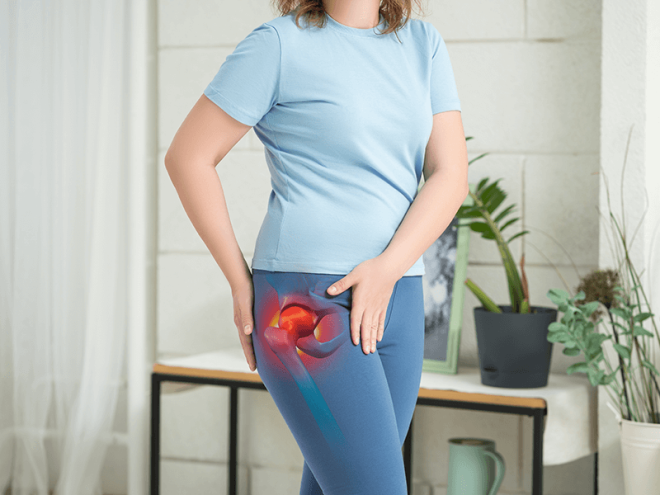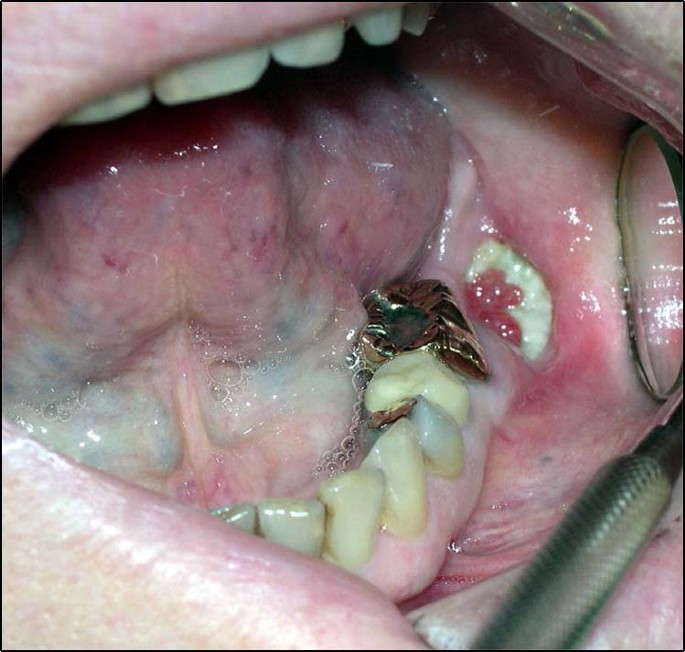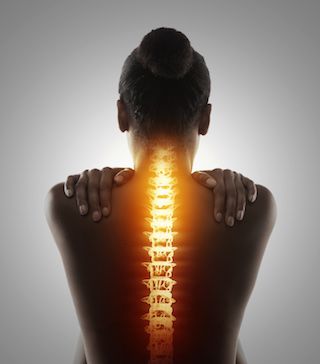Avascular necrosis or Osteonecrosis (AVN), also known as aseptic necrosis and osteonecrosis; A condition in which poor blood supply to an area of bone leads to bone death.
For example, Avascular necrosis or Osteonecrosis (AVN) of the hip may be caused by a fracture, joint dislocation, excessive alcohol intake, long-term steroid use or secondary to certain medical conditions.
Avascular necrosis or Osteonecrosis (AVN) of the hip, also called femoral head avascular necrosis, is most common. The thigh bone is called the femur, and the head of the femur is called the femoral head. This head attaches to the socket in the pelvic bone forming the hip joint. Other areas that may be affected are the shoulders, knees, hands and feet. The bone breaks down and eventually collapses.
Avascular necrosis or Osteonecrosis of the hip could be caused by fracture, joint dislocation, certain medical conditions, excessive alcohol intake or long-term use of high-dose steroid medications. The condition can affect anyone but is mostly seen in people 30 to 50 years of age.
Causes of Avascular necrosis or Osteonecrosis
In about one-fourth of cases, the cause of Avascular necrosis or Osteonecrosis (AVN) remains unknown. However, in other cases, it is a secondary condition that occurs when blood flow is reduced or cut off, which can be caused by:
- Trauma to bone or joint.
- Steroid therapies.
- Cancer treatments involve radiation to or near the bone or joint.
- Fatty deposits in blood vessels or even fat emboli (fat clots), which can block the blood vessels that supply the bone and joint.
Certain diseases can reduce blood flow to the bone, such as:
- Sickle cell.
- Gaucher disease.
- Diabetes.
- Pancreatitis.
- Human immunodeficiency virus (HIV)or acquired immunodeficiency syndrome (AIDS).
- Lupus.
Risk factors for developing Avascular necrosis or Osteonecrosis
- Trauma.
- Prolonged high dose bisphosphonate use (a medication to increase bone density) that causes the osteonecrosis of the jawbone.
- Alcoholism.
- Certain medical treatments, such as radiation therapy for cancer or organ transplantation.
Symptoms of Avascular necrosis or Osteonecrosis

In the initial stages, avascular necrosis or osteonecrosis may not have any symptoms. However, as the condition progresses, it presents itself with mild pain that increases in severity over time. While pain might only result from putting weight on it at first, eventually, the pain may arise even when the patient is at rest. This is followed by a limited range of motion for the joint.
Pain from avascular necrosis or osteonecrosis of the hip typically centers on the groin, thigh or buttock. Though, other areas that may be affected include the shoulder, knee, foot and hand. Some people develop the condition on both sides (bilaterally), such as in both hips.
Diagnosis
To diagnose avascular necrosis or osteonecrosis, a doctor should conduct a complete physical exam and advise the following tests:
- Blood tests to rule out rheumatoid arthritis, sickle cell anemia, human immunodeficiency virus (HIV)or acquired immunodeficiency syndrome (AIDS), lupus and coagulation profile.
- X-rays, magnetic resonance imaging (MRI) and computed tomography (CT) scan.
- Radionucleotide bone scan.
- Bone biopsy.
- Functional evaluation of bone (measuring the pressure inside the bone via surgical intervention).
Allopathic Treatment for avascular necrosis or osteonecrosis
Allopathic treatment of avascular necrosis or osteonecrosis aims to just provide symptom relief and prevent the condition from worsening. Surgery may be done if needed.
Allopathic treatment include:
Conservative treatments
- Nonsteroidal anti-inflammatory drugs to help relieve pain.
- Osteoporosis medications, such as alendronate, may paradoxically slow down the progression of avascular necrosis if used in the right dose and frequency.
- Cholesterol-lowering medication to reduce the amount of cholesterol in the blood, which may help prevent the blockage of blood vessels due to lipid plaques.
- Using blood thinners to prevent clots in the blood vessels supplying the bones.
- Adequate rest and restricting physical activity.
- Using crutches to decrease the stress over the joint.
- Rehabilitation and exercises/physiotherapy.
- Electrical stimulation to stimulate new bone growth to replace damaged bones.
Regenerative allopathic medicine
- Stem cells from the bone marrow aspiration and concentration is a newer procedure. This may help in the early stages of avascular necrosis of the hip by potentially growing new bone.
Research is underway to confirm the efficacy of this treatment. ????
Surgery
In allopathic treatment, surgical procedures may be recommended for avascular necrosis or osteonecrosis and may include:
- Bone graft or transplant: A section of healthy bone from another part of the body is used to strengthen the area of the affected bone.
- Core decompression: Part of the inner layer of the bone is removed.
- Bone osteotomy (reshaping): A wedge of bone is removed from the joint to help reduce the weight on the damaged bone.
- Joint replacement: Done if the bone has collapsed or other treatments failed, the damaged parts of the joint are replaced with plastic or metal parts.
Homeopathic treatment for avascular necrosis or osteonecrosis
Homeopathic treatment for bones & joints diseases like avascular necrosis or osteonecrosis, depends on the underlying causes or conditions, here are few Homeopathic medicine works best for avascular necrosis or osteonecrosis: –
Calceriqa Fluorica

A powerful tissue remedy for hard, stony glands, varicose and enlarged veins, avascular necrosis or osteonecrosis and malnutrition of bones. Hard knots in female breast. Goiter. Congenital hereditary syphilis. Induration threatening suppuration. Many cases of cataract have undoubtedly been influenced favorably by it. Congenital syphilis manifests itself in ulcerating of mouth and throat, caries and necrosis with boring pains and heat in parts. Arterio-sclerosis; threatened apoplexy. Tuberculosis. Used after operations, the tendency to adhesions is reduced. Ganglia or encysted tumors at the back of the wrist. Gouty enlargements of the joints of the fingers. Exostoses on fingers. Chronic synovitis of knee joint. Chronic lumbago; aggravated on beginning to move and ameliorated on continued motion. Osseous tumors. Rachitic enlargement of femur in infants. Pain lower part of back, with burning.
vascular tumors with dilated blood-vessels, and for varicose or enlarged veins. Aneurism. Valvular disease. When the tuberculous toxins attack the heart and blood-vessels.
Pulsatilla Pratensis
Drawing, intense pain in thighs and legs, with restlessness, sleeplessness and chilliness. Pain in limbs, shifting rapidly; tensive pain, letting up with a snap. Numbness around elbow. Hip-joint painful; avascular necrosis or osteonecrosis. Knees swollen, with tearing, drawing pains. Boring pain in heels toward evening; suffering worse from letting the affected limb hang down. Veins in forearms and hands swollen. Feet red, inflamed, swollen. Legs – feel heavy and weary.
Vipera Berus
Increase in reflexes, paresis supervenes, paraplegia of the lower extremities extending upwards. Acute ascending paralysis of Landry. Hematuria. Cardiac dropsy. Inflammation of veins with severe swelling; bursting sensation. Hepatomegaly. Ailments of menopause. Edema of glottis. Polyneuritis, poliomyelitis. Face excessively swollen. Lips and tongue swollen, livid, protruding. Tongue dry, brown, black, avascular necrosis or osteonecrosis. Speech difficult. Violent pain in enlarged liver, with jaundice and fever; extends to shoulder and hip.
Patients are obliged to keep the extremities elevated. When they are allowed to hang down, it seems as if they would burst, and the pain is unbearable. Varicose veins and acute phlebitis. Veins swollen, sensitive; bursting pain. Severe cramps in lower extremities.
Sulphur
Drawing pain between shoulders. Stiffness of nape. Sensation as if vertebrae glided over each other. Trembling of hands. Hot, sweaty hands. Rheumatic pain in shoulders. Heaviness; paretic feeling. Rheumatic gout, with itching. Burning in soles and hands at night. Avascular necrosis or osteonecrosis. Sweat in armpits, smelling like garlic. Drawing and tearing in arms and hands. Stiffness of knees and ankles. Cannot walk erect; stoop shouldered. Ganglion.
Lycopodium Clavatum
Best adapted to people intellectually keen, but of weak, muscular power. Deep-seated, progressive, chronic diseases. Carcinoma. Emaciation. Debility in morning. Numbness, drawing and tearing in limbs, especially while at rest or at night. Heaviness of arms. Tearing in shoulder and elbow joints. One foot hot, the other cold. Chronic gout, with deposits in joints, avascular necrosis or osteonecrosis. Profuse sweat of the feet. Pain in heel on treading as from a pebble. Painful callosities on soles; toes and fingers contracted. Sciatica, worse right side. Cannot lie on the painful side. Hands and feet numb. Cramps in calves and toes. Limbs go to sleep. Twitching and jerking.
Merc solubilus

Weakness of limbs. Bone pains and in limbs; worse, night. Patients are very sensitive to cold. Oily perspiration. Trembling extremities, especially hands, paralysis agitans. Lacerating pain in joints. Cold, clammy sweat on legs at night. Dropsical swelling of feet and legs. Bruised pain in lower back, especially when sitting. Tearing pain in coccyx; better, pressing on abdomen. Avascular necrosis or osteonecrosis.
Calcerea Carbonica
Its chief action is centered in the vegetative sphere, impaired nutrition being the keynote of its action, the glands, skin, and bones, being instrumental in the changes wrought. Increased local and general perspiration, swelling of glands, scrofulous and rachitic conditions generally offer numerous opportunities for the exhibition of Calcarea. Incipient phthisis. It covers the tickling cough, fleeting chest pains, nausea, acidity and dislike of fat. Gets out of breath easily. A jaded state, mental or physical, due to overwork. Abscesses in deep muscles; polypi and exostoses. Pituitary and thyroid disfunction. Raised blood coagulability. Swelling of joints, especially knee. Burning of soles of feet. Sweat of hands. Arthritic nodosities and avascular necrosis or osteonecrosis. Soles of feet raw. Feet feel cold and dead at night. Old sprains. Tearing in muscles.
Stramonium
Sensation as if limbs were separated from body. Delirium tremens. Absence of pain and muscular mobility especially of muscles of expression and of locomotion. Gyratory and graceful motions; avascular necrosis or osteonecrosis. Parkinson’s disease. Graceful, rhythmic motions. Convulsions of upper extremities and of isolated groups of muscles. Chorea: spasms partial, constantly changing. Violent pain in hip. Trembling, twitching of tendons, staggering gait.
Strontium Carb
Rheumatic pains, chronic sprains, stenosis of esophagus. Pains make patients faint or sick all over. Chronic sequelae of hemorrhages, after operations with much oozing of blood and coldness and prostration. Arterio-sclerosis. Affections of bones, especially femur; avascular necrosis or osteonecrosis. Restlessness at night, smothering feeling. For shock after surgical operations. Neuritis, great sensitiveness to cold. Sciatica with oedema of ankle. Rheumatic pain in shoulders. Rheumatism with diarrhea. Gnawing as if in marrow of bones. Cramps in calves and soles. Chronic spasms, particularly of ankle joint. Edematous swelling. Icy-cold feet. Rheumatic pains, especially in joints. Veins of hands engorged.
Arsenicum Album
Trembling, twitching, spasms, weakness, heaviness, uneasiness. Cramps in calves. Swelling of feet. Sciatica. Burning pains. Peripheral neuritis. Diabetic gangrene. Ulcers on heel. Paralysis of lower limbs with atrophy; avascular necrosis or osteonecrosis. Weakness in spinal bone. Drawing in of shoulders. Pain and burning in back.
Fluoric Acid
Especially adapted to chronic diseases with syphilitic history. Necrosis of long bones. The bones include humerus, femora and tibia. Necrosis appears in long bones. Necrosis of the bones of the ear, avascular necrosis or osteonecrosis.
Fluoric Acid helps in improving the blood circulation and preventing further necrosis of bones. Inflammation of joints of fingers. Feeling like a splinter under nail. Nails crumble. Caries and necrosis, especially of long bones. Coccygodynia. Ulcer over tibia.
Silicea Tera
Silicea is considered among the best natural medicines for avascular necrosis or osteonecrosis of a variety of bones ranging from long to small bones for example: The necrosis of jaw, wrist bones, hand bones, feet bones, ankle, knees and long bones —including humerus, femur and tibia — are the sites of action for using Silicea. The general symptom for using Silicea is sensitivity to cold air when bone pain worsens even from the slightest exposure to cold air. Warmth brings relief.
Symphytum
Symphytum stimulates the growth of epithelium on ulcerated surfaces. Symphytum can be considered in all cases where the bone has suffered damage following fractures, avascular necrosis or osteonecrosis. It helps in proper knitting of the bone. This is helped by providing the necessary callous material needed for bone reformation. It acts as a preventive agent against necrosis as the bone is very neatly and efficiently woven by this medicine. Acts good in wounds penetrating to perineum and bones, and in non-union of fractures, irritable stump after amputation, irritable bone at point of fracture. Psoas abscess. Pricking pain and soreness of periosteum, tendons and the periosteum. Acts on joints generally. Neuralgia of knee.
Hekla Lava

Marked action upon the jaws. Of great use in exostosis, gum abscess, difficult teething. Nodosities, caries of bone, osteitis, periostitis, osteosarcoma; rachitis. Tumors. Bone necrosis. Necrosis and sinus after mastoid operation. Ulceration of nasal bones. Avascular necrosis or osteonecrosis. Facial neuralgia from carious teeth. Toothache, with swelling about jaws. Abscess of gums. Enlargement of maxillary bone. Cervical glands enlarged and indurated.
Syphilinum
Syphilinum is well known for its beneficial action on body tissues wherever the destructive process is present. Apart from its universal healing action to stop the destruction of body tissues, Syphilinum is of great help in treating avascular necrosis or osteonecrosis. The most dominant feature for selecting Syphilinum in any given case of AVN is the worsening of bone pains at night. The pains may compel the patient to walk, which seems to bring relief.
Specific pattern regarding the appearance and disappearance of pain. The pattern followed is a gradual increase in bone pains and in the same way, a gradual disappearance of pains. Worsening of pains because of heat and some relief by applying cold water.
Natrum Sulphuricum
Natrum Sulph is one of the most beneficial medicines when dealing with hip joint avascular necrosis or osteonecrosis. Swelling of axillary glands. Inflammation around the root of nails. Burning in soles; edema lower extremities; itching between toes. Gout. Pain in limbs compels frequent change in position. Pain in hip-joints, worse, stooping. Stiffness of knees, cracking of joints. Rheumatism, worse in damp cold weather. Itching when undressing. Violent pains in back of neck, and at base of brain. Piercing pain between scapulae. Spinal meningitis; opisthotonos.
Asafoetida
Asafoetida is a wonderful medicine for avascular necrosis or osteonecrosis of the tibial joints, deep ulcerations, caries of bones, especially in the syphilitic organism; here the extreme sensitiveness and terrible throbbing, nightly pains, guiding to its use. Darting pain and caries in bones. Periosteum painful, swollen, enlarged. Ulcers affecting bones; thin, ichorous pus.
Aurum Metallicum
Exostosis, caries, nightly bone-pains, especially cranial, nasal, and palatine. Glands swollen in scrofulous subjects. Necrosis in nasal and palatine bones.
Destruction of bones, like secondary syphilis. Pain in bones of head, lumps under scalp, exostosis with nightly pains in bones. Caries of nasal, palatine and mastoid bones. Soreness of affected bones, better in open air, worse at night. Avascular necrosis or osteonecrosis.
Caries of ossicula. Obstinate fetid otorrhea after scarlatina. External meatus bathed in pus. Chronic nerve deafness; Labyrinthine disease due to syphilis. Tearing in zygoma. Mastoid and other facial bones inflamed.
Nose ulcerated, painful, swollen, obstructed. Inflammation of nose; caries; fetid discharge, purulent, bloody, with boring pains. Putrid smell from nose. Sensitive smell. Horrible odor from nose and mouth. Knobby tip of nose.
All the blood seems to rush from the head to lower limbs. Dropsy of lower limbs. Orgasm, as if blood were boiling in all veins. Paralytic, tearing pains in joints. Knees weak.
Phosphorus
Phosphorus is an effective remedy for treating lower jaw avascular necrosis or osteonecrosis. Ascending sensory and motor paralysis from the ends of fingers and toes. Stitches in elbow and shoulder joints. Burning of feet. Weakness and trembling, from every exertion. Can scarcely hold anything with his hands. Tibia inflamed and becomes necrosed. Arms and hands become numb. Post-diphtheritic paralysis, with formication of hands and feet. Joints suddenly give way. Burning in back; pain as if broken. Heat between the shoulder-blades. Weak spine.
Tearing pain in facial bones; circumscribed redness in one or both cheeks. Swelling and necrosis of lower jaw.
Swelled and easily bleeding gums, ulcerated. Toothache after washing clothes. Nursing sore mouth. Burning in esophagus. Stricture of esophagus.
How is avascular necrosis prevented?
The following measures can help reduce the risk of avascular necrosis (AVN):
- Since low vitamin D. levels are associated with AVN, discuss with your healthcare practitioner about routine monitoring of your vitamin D levels and supplementation.
- Avoiding smoking.
- Limiting alcohol consumption.
- Keeping your cholesterol levels in check.
- Monitoring steroid use with the help of the doctor.
- Never using exotic supplements for muscle building because these may be contaminated with steroids.
P. S: This article is only for doctors having good knowledge about Homeopathy and allopathy, for learning purpose(s).
For proper consultation and treatment, please visit our clinic.
None of above-mentioned medicine(s) is/are the full/complete treatment, but just hints for treatment; every patient has his/her own constitutional medicine.
To order medicine by courier, please send your details at WhatsApp– +923119884588

Dr. Sayyad Qaisar Ahmed (MD {Ukraine}, DHMS), Abdominal Surgeries, Oncological surgeries, Gastroenterologist, Specialist Homeopathic Medicines.
Senior research officer at Dnepropetrovsk state medical academy Ukraine.
Location: Al-Haytham clinic, Umer Farooq Chowk Risalpur Sadder (0923631023, 03119884588), K.P.K, Pakistan.
Find more about Dr Sayed Qaisar Ahmed at:
https://www.youtube.com/Dr Qaisar Ahmed
https://www.facebook.com/ahmed drqaisar
